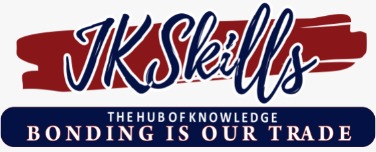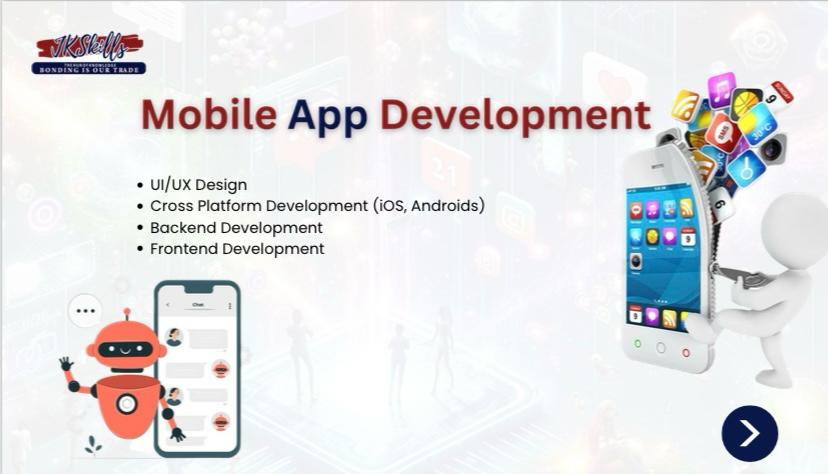Web Development
Web app development is the process of building applications that are accessible through web browsers. Unlike traditional desktop applications, web apps are not installed on a user’s device, making them cross-platform by nature.For JKSkillHub, a platform focusing on skill development, it’s crucial to have a robust, user-friendly, and efficient website to attract learners and ensure smooth interactions. Here’s a broad outline of the web development process and focus areas tailored for JKSkillHub.
Website structure & Design
- User Interface (UI): The design must be simple yet professional, with easy navigation to make it user-friendly for all visitors. The design should include responsive layouts, clean typography, and intuitive navigation menus.
- User Experience (UX): Focus on creating an engaging experience for the users, ensuring they can easily find and enroll in courses, access learning materials, and navigate the site
Front-End Development
- HTML/CSS: Create well-structured content using HTML5 and style the layout with CSS. Ensure accessibility features like ARIA roles and proper semantic HTML
- JavaScript: Use JavaScript or libraries like React.js or Vue.js for interactive features like course filters, forms, and dynamic content updates.
Responsive Design: Ensure the website is optimized for mobile, tablet, and desktop views using CSS media queries or frameworks like Bootstrap.
Back-End Development
1. Database Management: Use a database like MySQL, or MongoDB to store information about courses, users, registrations, and other data.
2. Server-Side Development: Use a back-end framework like Node.js, or PHP to handle requests, manage user accounts, and process course enrollments.
3. Authentication: Implement secure login systems (e.g., using OAuth, JWT, or session-based authentication) to allow users to register, log in, and track their progress.

Mobile-App Development
Mobile app development for a platform like JKSkillHub, which I assume is related to skill-building or educational services, would typically focus on creating an engaging, user-friendly app to help users learn, upskill, or gain certifications. Here’s a broad overview of the steps involved in the mobile app development process for such a platform:
1. Planning & Research
Target Audience: Understand the specific audience (students, professionals, or businesses) and their needs for skill-building.
Competitor Analysis: Study similar platforms and apps to identify features that work and areas for improvement.
Platform Selection: Decide whether to develop for Android, iOS, or both (cross-platform development).
2. Feature Implementation
Key features for an app like JKSkillHub could include:
User Registration & Profiles: Allow users to create and customize their profiles with information like skills, progress, and preferences.
Course Catalog: A searchable catalog of skill-building courses, certifications, tutorials, and more.
Progress Tracking: Show the user’s progress on different courses, with visual feedback on their achievements.
Interactive Learning Tools: Features such as quizzes, challenges, and video tutorials to engage users actively.
Discussion Forums: Allow users to interact with instructors and peers.
Push Notifications: Remind users of course deadlines, new content, or offers.
Payment Integration: For in-app purchases like course fees, memberships, or premium content.
Social Sharing: Users can share achievements or courses on social media.
Gamification: Points, badges, and leaderboards to encourage users to engage more with the content.
Offline Mode: Ability to access certain content offline, enhancing user experience.
3. Wireframing & UI/UX Design
User Flow: Design the app’s structure and flow, mapping out the journey from onboarding to course completion.
UI/UX Design: Focus on creating an intuitive and visually appealing design. Easy navigation, clean layout, and consistent branding would be crucial.
Prototyping: Create prototypes and get feedback from users to refine design and features.
4. Development
Frontend Development: This involves coding the app’s user interface and implementing the design. Depending on the platform, tools like React Native, Flutter (cross-platform), Swift (for iOS), or Kotlin/Java (for Android) are used.
Backend Development: Set up databases, server-side logic, and APIs. The backend supports user authentication, course management, progress tracking, etc. Technologies like Node.js, Django, Ruby on Rails, or PHP might be used.
Integration: Integrate third-party tools and services like payment gateways (Stripe, PayPal), video hosting (YouTube, Vimeo), or social media sharing.
5. Testing
Functionality Testing: Ensure all features work as expected (registration, course access, quizzes).
Performance Testing: Ensure smooth performance, especially when handling a large number of users or content.
Security Testing: Verify that user data is secure (especially for payment systems) and that the app adheres to data protection regulations.
Compatibility Testing: Make sure the app works across various devices and screen sizes.
Usability Testing: Gather user feedback on ease of navigation and overall experience.
6. Deployment
App Store Submission: Submit the app to the Google Play Store or Apple App Store for approval. Follow the respective store guidelines to avoid delays.
Backend Launch: Deploy the backend to a live server, ensuring that it can handle user traffic and interactions.
7. Maintenance & Updates
User Feedback: Gather feedback from users to identify bugs or new feature requests.
App Updates: Regularly update the app with bug fixes, security patches, and new features.
Content Updates: Continuously add new courses, tutorials, or learning materials.
Frequently Asked Questions
JKSkillHub provides comprehensive web development courses covering:
HTML and CSS: Learn the fundamentals of web structure and styling.
JavaScript: Understand client-side scripting to create interactive web pages.
Responsive Design: Master techniques to ensure websites function seamlessly across various devices.
Graduates can explore roles such as Front-End Developer, Back-End Developer, Full-Stack Developer, Web Designer, and more. The demand for skilled web developers is consistently high, offering numerous opportunities in various industries.
JKSkillHub offers comprehensive courses in mobile app development, focusing on both Android and iOS platforms. These courses cover essential programming languages and frameworks such as Java, Kotlin, Swift, and React Native. The curriculum is designed to equip students with the skills needed to design, build, and publish mobile applications.
For information regarding placement assistance, it’s best to contact JKSkillHub directly to obtain the most accurate and up-to-date details.

